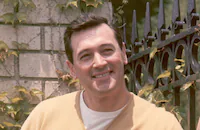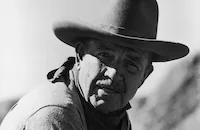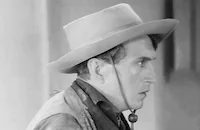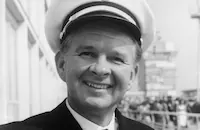The Undefeated
Brief Synopsis
Cast & Crew
Andrew V. Mclaglen
John Wayne
Rock Hudson
Tony Aguilar
Roman Gabriel
Marian Mccargo
Film Details
Technical Specs

Synopsis
At the end of the Civil War, Union Col. John Henry Thomas, his adopted son Blue Boy, a Cheyenne Indian, and 10 of his command travel to Oklahoma, intending to sell horses to the United States Cavalry. Offered a poor price by the government, the indignant Thomas decides to transport the herd to Durango, Mexico, for sale to the beleaguered Emperor Maximilian. While crossing the Rio Grande the Yankees encounter Confederate Col. James Langdon who, having destroyed his Louisiana plantation, intends with family and friends to reestablish the Confederacy in Mexico. Together the Americans repel a group of Mexican bandits who have attacked the Confederate wagon train. In gratitude Langdon arranges a Fourth of July celebration attended by his widowed sister-in-law Ann and daughter Charlotte. At the festivity Charlotte and Blue Boy fall in love, while the men enjoy a free-for-all. When Blue Boy later warns the Southerners that Maximilian's emissary has been murdered, they refuse to believe him and beat him in retaliation for his advances to Charlotte. Langdon's party proceeds to Durango, where they are promptly captured by General Rojas, a follower of Maximilian's nemesis, Juárez. Rojas informs the Yankees that he will kill his hostages unless the herd is given to the Juaristas. Complying with his request, Thomas saves his former adversary. Together again, Confederates and Yankees return to the United States.

Director

Andrew V. Mclaglen
Cast

John Wayne

Rock Hudson
Tony Aguilar
Roman Gabriel
Marian Mccargo
Lee Meriwether
Merlin Olsen
Melissa Newman

Bruce Cabot
Michael Vincent

Ben Johnson
Edward Faulkner

Harry Carey Jr.

Paul Fix

Royal Dano
Richard Mulligan

Carlos Rivas

John Agar
Guy Raymond
Don Collier
Big John Hamilton
Dub Taylor
Henry Beckman
Victor Junco
Robert Donner
Pedro Armendariz

James Dobson
Rudy Diaz
Richard Angarola
James Mceachin
Gregg Palmer
Juan Garçia
Kiel Martin
Bob Gravage
Crew
L. B. Abbott
Carl Anderson
Frank Balchus
James Lee Barrett
Chester L. Bayhi
Luster Bayless
William Clothier
Art Cruickshank
Jack Cunningham
David Dockendorf
Cary Eurist
Clarence Eurist
Robert Forrest
David Grayson
Stanley L. Hough
Robert L. Jacks
Diane Jones
Chuck King
Alfred Lebowitz
Edith Lindon
Leo Lotito
Robert Mathews
Hugo Montenegro
Al Myers
Hal Needham
Richard Overton
Mark Reedall
Sheral Ross
Walter M. Scott
Robert Simpson
Herbert Spencer
Dan Striepeke
Bill Thomas
Ray Thompson
James Vaiana
Hank Wynands

Film Details
Technical Specs

Articles
TCM Remembers - John Agar
Popular b-movie actor John Agar died April 7th at the age of 81. Agar is probably best known as the actor that married Shirley Temple in 1945 but he also appeared alongside John Wayne in several films. Agar soon became a fixture in such films as Tarantula (1955) and The Mole People (1956) and was a cult favorite ever since, something he took in good spirits and seemed to enjoy. In 1972, for instance, the fan magazine Famous Monsters of Filmland mistakenly ran his obituary, a piece that Agar would later happily autograph.
Agar was born January 31, 1921 in Chicago. He had been a sergeant in the Army Air Corps working as a physical trainer when he was hired in 1945 to escort 16-year-old Shirley Temple to a Hollywood party. Agar apparently knew Temple earlier since his sister was a classmate of Temple's. Despite the objections of Temple's mother the two became a couple and were married shortly after. Temple's producer David Selznick asked Agar if he wanted to act but he reportedly replied that one actor in the family was enough. Nevertheless, Selznick paid for acting lessons and signed Agar to a contract.
Agar's first film was the John Ford-directed Fort Apache (1948) also starring Temple. Agar and Temple also both appeared in Adventure in Baltimore (1949) and had a daughter in 1948 but were divorced the following year. Agar married again in 1951 which lasted until his wife's death in 2000. Agar worked in a string of Westerns and war films such as Sands of Iwo Jima (1949), Breakthrough (1950) and She Wore a Yellow Ribbon (1949). Later when pressed for money he began making the films that would establish his reputation beyond the gossip columns: Revenge of the Creature (1955), The Brain from Planet Arous (1957), Invisible Invaders (1959) and the mind-boggling Zontar, the Thing from Venus (1966). The roles became progressively smaller so Agar sold insurance and real estate on the side. When he appeared in the 1988 film Miracle Mile his dialogue supposedly included obscenities which Agar had always refused to use. He showed the director a way to do the scene without that language and that's how it was filmed.
By Lang Thompson
DUDLEY MOORE, 1935-2002
Award-winning actor, comedian and musician Dudley Moore died on March 27th at the age of 66. Moore first gained notice in his native England for ground-breaking stage and TV comedy before later building a Hollywood career. Like many of his peers, he had an amiable, open appeal that was balanced against a sharply satiric edge. Moore could play the confused innocent as well as the crafty schemer and tended to command attention wherever he appeared. Among his four marriages were two actresses: Tuesday Weld and Suzy Kendall.
Moore was born April 19, 1935 in London. As a child, he had a club foot later corrected by years of surgery that often left him recuperating in the hospital alongside critically wounded soldiers. Moore attended Oxford where he earned a degree in musical composition and met future collaborators Peter Cook, Jonathan Miller and Alan Bennett. The four formed the landmark comedy ensemble Beyond the Fringe. Though often merely labelled as a precursor to Monty Python's Flying Circus, Beyond the Fringe was instrumental in the marriage of the piercing, highly educated sense of humor cultivated by Oxbridge graduates to the modern mass media. In this case it was the revue stage and television where Beyond the Fringe first assaulted the astonished minds of Britons. Moore supplied the music and such songs as "The Sadder and Wiser Beaver," "Man Bites God" and "One Leg Too Few." (You can pick up a CD set with much of the stage show. Unfortunately for future historians the BBC commonly erased tapes at this period - why? - so many of the TV episodes are apparently gone forever.)
Moore's first feature film was the 1966 farce The Wrong Box (a Robert Louis Stevenson adaptation) but it was his collaboration with Peter Cook on Bedazzled (1967) that's endured. Unlike its tepid 2000 remake, the original Bedazzled is a wolverine-tough satire of mid-60s culture that hasn't aged a bit: viewers are still as likely to be appalled and entertained at the same time. Moore not only co-wrote the story with Cook but composed the score. Moore appeared in a few more films until starring in 10 (1979). Written and directed by Blake Edwards, this amiable comedy featured Moore (a last-minute replacement for George Segal) caught in a middle-aged crisis and proved popular with both audiences and critics. Moore's career took another turn when his role as a wealthy alcoholic who falls for the proverbial shop girl in Arthur (1981) snagged him an Oscar nomination as Best Actor and a Golden Globe win.
However Moore was never able to build on these successes. He starred in a passable remake of Preston Sturges' Unfaithfully Yours (1984), did another Blake Edwards romantic comedy of moderate interest called Micki + Maude (1984, also a Golden Globe winner for Moore), a misfired sequel to Arthur in 1988 and a few other little-seen films. The highlight of this period must certainly be the 1991 series Orchestra where Moore spars with the wonderfully crusty conductor Georg Solti and leads an orchestra of students in what's certainly some of the most delightful television ever made.
By Lang Thompson

TCM Remembers - John Agar
Quotes
Americans in Mexico are delivering horses to a very unpopular government... Why should we expect trouble?- Col. John Henry Thomas
McCartney.- Shortgrub
Mr. McCartney. Shortgrub, I said a lot of mean things to the boys, didn't I?- McCartney
Yeah, you did.- Shortgrub
Tell them from me, I meant every damn word.- McCartney
When I find the time, I'm going to write the social history of bourbon.- Col. James Langdon
You went out there to talk! Why did you kill that man?- Ann Langdon
Conversation just kinda dried up.- John Henry Thomas
Hold on! Wait a minute! I didn't do ANYTHING!- Gregg Palmer as Ezra Parker
I know, but you should have!- John Wayne as John Henry Thomas
Sir, I don't...- Union Sgt. at river
I know, sergeant! But if I can't have the whole dog, then I don't want the TAIL!- Union Capt. at river
Yes, sir.- Union Sgt. at river
Trivia
Notes
Filmed on location in Mexico and in Baton Rouge, Louisiana.

Miscellaneous Notes
Released in United States Fall November 1969
Released in United States Fall November 1969













